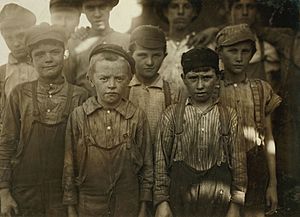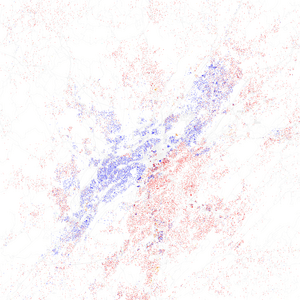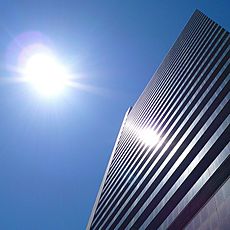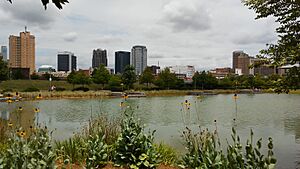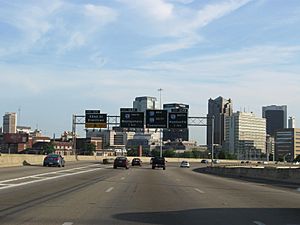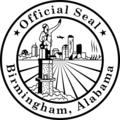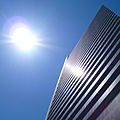Birmingham, Alabama facts for kids
Quick facts for kids
Birmingham
|
|||||
|---|---|---|---|---|---|
|
Downtown Birmingham
City Hall
|
|||||
|
|||||
| Nicknames:
"The Magic City", "Pittsburgh of the South"
|
|||||
| Country | United States | ||||
| State | Alabama | ||||
| Counties | Jefferson, Shelby | ||||
| Incorporated | December 19, 1871 | ||||
| Named for | Birmingham, England, UK | ||||
| Government | |||||
| • Type | Mayor – Council | ||||
| Area | |||||
| • City | 149.54 sq mi (387.31 km2) | ||||
| • Land | 147.02 sq mi (380.77 km2) | ||||
| • Water | 2.52 sq mi (6.53 km2) | ||||
| Elevation | 597 ft (182 m) | ||||
| Population
(2020)
|
|||||
| • City | 200,733 | ||||
| • Estimate
(2023)
|
196,644 | ||||
| • Rank | 129th in the United States 2nd in Alabama |
||||
| • Density | 1,365.37/sq mi (527.17/km2) | ||||
| • Urban | 774,956 (US: 58th) | ||||
| • Urban density | 1,521.7/sq mi (587.5/km2) | ||||
| • Metro | 1,115,289 (50th) | ||||
| Demonym(s) | Birminghamian | ||||
| Time zone | UTC−6 (CST) | ||||
| • Summer (DST) | UTC−5 (CDT) | ||||
| ZIP Codes |
35201-35224, 35226, 35228-35229, 35231-35238, 35242-35244, 35246, 35249, 35253-35255, 35259-35261, 35266, 35270, 35282-35283, 35285, 35287-35288, 35290-35298
|
||||
| Area codes | 205, 659 | ||||
| FIPS code | 01-07000 | ||||
| GNIS feature ID | 2403868 | ||||
Birmingham (pronounced BUR-ming-ham) is a city in the central part of Alabama, United States. It's the main city of Jefferson County, which is Alabama's most populated county. In 2023, Birmingham had about 196,910 people. This makes it Alabama's second-largest city, right after Huntsville.
The larger Birmingham area has over 1.1 million people. This makes it the biggest metropolitan area in Alabama. Birmingham is a key city in the Deep South and Appalachian regions.
Birmingham was started in 1871, after the American Civil War. It was formed by joining three small farm towns. The city quickly grew into a major center for industry and railroads. Its main focus was mining, making iron and steel, and building railroads. The city was named after Birmingham in Warwickshire, England, which was also a big industrial city.
Because it grew so fast between 1881 and 1920, Birmingham was nicknamed The Magic City and The Pittsburgh of the South. Like Pittsburgh, Birmingham was known for making iron and steel. It was also a big hub for railroads in the South. Over time, Birmingham's economy became more diverse. Now, besides manufacturing, it's important for banking, telecommunications, healthcare, and college education. It's a major business center in the Southeastern United States.
Birmingham is home to several important universities and colleges. These include the University of Alabama at Birmingham (UAB), Samford University, and Miles College. The area has major schools for medicine, dentistry, and engineering. Birmingham also hosts the headquarters for two big college sports groups: the Southeastern Conference and the Southwestern Athletic Conference.
Contents
History of Birmingham
How Birmingham Began and Grew
Birmingham was founded on June 1, 1871. A group of investors called the Elyton Land Company started it. They sold land near where two major railroads were planned to cross. This spot was special because it had lots of iron ore, coal, and limestone nearby. These three materials are all needed to make steel.
Birmingham is one of the few places in the world where you can find all three of these minerals close together. The city was planned from the start to be a huge industrial center. Its founders named it after Birmingham, England, to show its industrial goals. The city's growth slowed down for a bit due to a sickness outbreak and a financial crash in 1873. But after that, it grew incredibly fast.
In 1911, the town of Elyton and other nearby towns became part of Birmingham. The early 1900s brought huge growth, earning Birmingham the name "The Magic City." The downtown area changed from small buildings to a busy area with tall, impressive buildings and streetcar lines. Between 1902 and 1912, four large office buildings were built at a main intersection. This group of early skyscrapers was called "The Heaviest Corner on Earth."
The Great Depression in the 1930s hit Birmingham hard. Many people lost their jobs. Government programs like the New Deal helped by giving people work on city projects. These projects included improvements to Vulcan Park and Oak Mountain State Park. When World War II started, the demand for steel brought prosperity back to Birmingham. The city's industries grew and became more varied.
Even as the city grew, its people were not fairly represented in the state government. This meant that rural areas had more power than growing cities like Birmingham. This issue was finally addressed in the 1970s by a federal court ruling.
Birmingham and Civil Rights

In the 1950s and 1960s, Birmingham became very important in the civil rights movement. Local leaders like Fred Shuttlesworth bravely fought against unfair laws. Birmingham was sometimes called "Bombingham" because of many racially motivated bombings.
A key moment happened in 1963 when Shuttlesworth asked Martin Luther King Jr. to come to Birmingham. King and the Southern Christian Leadership Conference (SCLC) started "Project C" (for "Confrontation"). This was a big effort to end segregation. Protesters held daily sit-ins and marches. Police used tear gas, attack dogs, and fire hoses against them. More than 3,000 people were arrested, many of them high school students.
These protests helped end segregation in Birmingham. They also led to the Civil Rights Act of 1964. While in jail, Dr. King wrote his famous Letter from Birmingham Jail. This letter explained his reasons for fighting segregation. Birmingham is also known for a sad event on September 15, 1963. Four young Black girls were killed by a bomb at the 16th Street Baptist Church. This event inspired poems and songs.
In 1998, the Birmingham Pledge was created. It's a promise by the community to fight racism and prejudice. It has been used in many places around the world.
Recent History of Birmingham
In the 1970s, Birmingham focused on developing the University of Alabama at Birmingham (UAB). UAB became a major center for medicine and research. In 1971, Birmingham celebrated its 100th birthday with new public projects. These included improving Vulcan Park and building a large convention center. New skyscrapers also started to appear. These projects helped make the city's economy more diverse.
However, many people moved from the city to nearby suburbs. This was partly due to "white flight," where white families moved out of the city. Birmingham's population dropped from its highest point in 1960. In 1979, Dr. Richard Arrington Jr. became Birmingham's first African-American mayor.
In 2015, Birmingham was chosen to host the World Games in 2021. This event was delayed to 2022 because of the COVID-19 pandemic. It was the first time an American city hosted the World Games since 1981. After the 2020 census, Huntsville became Alabama's largest city by population. However, Birmingham remains the state's largest metropolitan area.
Geography and Climate
Birmingham's Location and Landscape
Birmingham is located in Jones Valley. This valley is surrounded by long, parallel mountain ridges. These are the ends of the Appalachian foothills. Small creeks flow through the valley into the Black Warrior River. The main railroad line cuts through the valley, where many early factories were built.
Red Mountain is just south of downtown. Many TV and radio towers are on this ridge. The area "Over the Mountain" is home to wealthier suburbs like Mountain Brook and Vestavia Hills. South of this area is the Cahaba River, which has many different kinds of plants and animals.
Ruffner Mountain is east of the city center. It's home to the Ruffner Mountain Nature Center. This is one of the biggest urban nature reserves in the United States. Birmingham covers about 149.5 square miles of land.
Surrounding Towns and Cities
Most of the Birmingham metropolitan area is outside the city itself. This area includes many different counties, cities, and school districts. Some people think having so many separate towns can make it harder for the region to grow together.
Here are some of the largest towns and cities near Birmingham:
Birmingham's Tallest Buildings
| Name | Stories | Height |
|---|---|---|
| Shipt Tower | 34 | 454 ft (138 m) |
| Regions-Harbert Plaza | 32 | 437 ft (133 m) |
| AT&T City Center | 30 | 390 ft (119 m) |
| Regions Center | 30 | 390 ft (119 m) |
| City Federal Building | 27 | 325 ft (99 m) |
Weather in Birmingham
Birmingham has a humid subtropical climate. This means it has hot summers, mild winters, and a lot of rain. In January, the average temperature is about 44°F (6.7°C). In July, the average temperature is about 81°F (27.2°C). It gets above 90°F (32°C) about 65 days a year.
Rainfall is spread out throughout the year. Sometimes it snows in winter, but not often. The most snow ever recorded in one day was 10.3 inches (26 cm) in March 1993.
Summers are hot and humid. Most summer rain comes from thunderstorms in the afternoon. Spring and fall are nice but can have strong thunderstorms and even tornadoes. Birmingham is in a part of the country called Dixie Alley, which gets many tornadoes. The area has been hit by strong tornadoes in 1977, 1998, and 2011.
The highest temperature ever recorded was 107°F (42°C) in July 1930. The lowest was -10°F (-23°C) in February 1899.
People of Birmingham
Population Changes
| Historical population | |||
|---|---|---|---|
| Census | Pop. | %± | |
| 1880 | 3,086 | — | |
| 1890 | 26,178 | 748.3% | |
| 1900 | 38,415 | 46.7% | |
| 1910 | 132,685 | 245.4% | |
| 1920 | 178,806 | 34.8% | |
| 1930 | 259,678 | 45.2% | |
| 1940 | 267,583 | 3.0% | |
| 1950 | 326,037 | 21.8% | |
| 1960 | 340,887 | 4.6% | |
| 1970 | 300,910 | −11.7% | |
| 1980 | 284,413 | −5.5% | |
| 1990 | 265,968 | −6.5% | |
| 2000 | 242,840 | −8.7% | |
| 2010 | 212,237 | −12.6% | |
| 2020 | 200,733 | −5.4% | |
| 2023 (est.) | 196,644 | −7.3% | |
| U.S. Decennial Census 1990 2000 2010 2020 |
|||
In 2020, there were about 200,733 people living in Birmingham. The city has a diverse population.
According to the 2010 U.S. census:
- 73.4% were African American
- 22.3% were White
- 3.6% were Hispanic or Latino (of any race)
- Other groups made up smaller percentages.
Religion in Birmingham
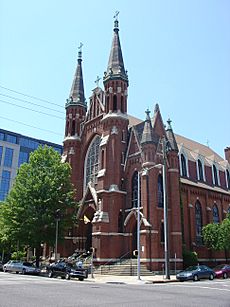
Birmingham has a very high number of Christians, especially Protestants. The Southern Baptist Convention has many churches and members in the area. The United Methodist Church and the Presbyterian Church in America also have a strong presence.
The city is home to the Roman Catholic Diocese of Birmingham. This diocese covers many counties and includes churches and schools. The Catholic television network EWTN is also based in the Birmingham area. There are also Eastern Orthodox Churches and a Unitarian Universalist church. The main campus of the Church of the Highlands, a large church, is located in Birmingham.
Birmingham's Economy
Major Industries
The steel industry has always been very important to Birmingham's economy. Even though it's not as dominant as it once was, steel production is still key. Companies like American Cast Iron Pipe Company (ACIPCO) and McWane are based here. Major steelmakers like U.S. Steel also have a presence. Vulcan Materials Company, which provides crushed stone for construction, is also based in Birmingham.
In the 1970s and 1980s, Birmingham's economy changed a lot. There were big investments in medical research at the University of Alabama at Birmingham (UAB). The UAB Hospital is a top medical center and does important research. UAB is now the largest employer in the area. Several healthcare companies are also headquartered in the city.
Birmingham is also a major center for banking. Regions Financial Corporation has its headquarters here. Many other banks also have a strong presence in the city.
Other Important Companies
Birmingham is home to many construction and engineering companies. These include Brasfield & Gorrie and Robins & Morton.
Two of the largest soft-drink bottling companies in the U.S. are in Birmingham. The Buffalo Rock Company bottles Pepsi products. Coca-Cola Bottling Company United is the third-largest Coca-Cola bottler in the country.
AT&T has a big presence in Birmingham, with a skyscraper downtown. Insurance companies like Blue Cross and Blue Shield of Alabama and Protective Life are also headquartered here.
Birmingham has seen some changes in its big companies. While some have moved or merged, new companies have grown. These include Encompass Health Corporation, Alabama Power Company, and Hibbett Sports. Many food companies like Jack's and Milo's Hamburgers are also based in Birmingham.
Culture and Attractions
Arts and Entertainment
Birmingham is a lively place for culture and entertainment in Alabama. It has many art galleries, including the Birmingham Museum of Art. This is the largest art museum in the Southeast. Downtown Birmingham is becoming a popular spot with new shops and restaurants.
The city is home to major ballet, opera, and symphony groups. These include the Alabama Ballet and the Alabama Symphony Orchestra.
- The historic Alabama Theatre shows movies, concerts, and performances.
- The Alys Stephens Center at UAB hosts the Alabama Symphony Orchestra and other shows.
- The Birmingham-Jefferson Convention Complex (BJCC) has theaters, concert halls, and an arena. It's home to the Birmingham Children's Theatre, one of the oldest children's theaters in the country.
- The historic Carver Theatre is home to the Alabama Jazz Hall of Fame. It offers concerts and jazz classes.
- The Birmingham Public Library has many programs for kids and adults.
- Oak Mountain Amphitheater is a large outdoor concert venue south of Birmingham.
Museums to Explore
Birmingham has several interesting museums. The biggest is the Birmingham Museum of Art, with a huge collection of art. For history, visit the Birmingham Civil Rights Institute. It tells the story of Birmingham's role in the U.S. Civil Rights Movement. It's next to the 16th Street Baptist Church.
Other history museums include the Southern Museum of Flight and Sloss Furnaces National Historic Landmark. The Alabama Jazz Hall of Fame shows exhibits about famous jazz musicians from Alabama.
The McWane Science Center is a fun place for science. It has hands-on exhibits, changing displays, and an IMAX dome theater. You can also see a huge collection of fossils there. Other unique museums include the Barber Vintage Motorsports Museum, which has the world's largest collection of motorcycles.
South of downtown, on Red Mountain, you'll find Vulcan Park. It features the world's largest cast iron statue of Vulcan, the Roman god of fire. You can go up the tower for amazing views of the city.
Fun Festivals and Events

Birmingham hosts many festivals that celebrate music, films, and local culture.
- The Sidewalk Moving Picture Festival brings filmmakers to Birmingham. It usually happens in late August.
- The Taste of 4th Avenue Jazz Festival is an all-day event in August with jazz music.
- Do Dah Day is an annual pet parade held in late May.
- The Schaeffer Eye Center Crawfish Boil is a music festival in May that raises money for charities.
- The annual Greek Festival celebrates Greek culture and food.
- The Lebanese Food Festival is held at St. Elias Maronite Church.
- Magic City Brewfest focuses on craft beer.
- Alabama Bound is a book fair that celebrates authors from Alabama.
Other Cool Places to Visit

The Vulcan statue is a famous symbol of Birmingham. It stands on a tower on Red Mountain, offering great views. The Birmingham Zoo is a large zoo with over 700 animals and a fun children's zoo.
The Birmingham Botanical Gardens is a huge 67-acre park. It has many different types of plants, including rose gardens and a Japanese garden. Splash Adventure in Bessemer is a water and theme park with slides and water rides.
Kelly Ingram Park is important for its role in civil rights protests. It's next to the historic 16th Street Baptist Church. Railroad Park opened in 2010 in downtown Birmingham. Oak Mountain State Park is a short drive south of the city. It's a great place for outdoor activities. To the west, Tannehill Ironworks Historical State Park shows the ruins of Civil War-era iron furnaces.
The Summit is a popular outdoor shopping center with many stores and restaurants.
Sports in Birmingham
| Sports Franchise | League | Sport | Stadium (capacity) |
|---|---|---|---|
| Birmingham Barons | Southern League (AA) | Baseball | Regions Field (8,500) |
| Birmingham Legion FC | USLC | Soccer | Protective Stadium (47,100) |
| Birmingham Squadron | NBA G League | Basketball | Legacy Arena (17,654) |
| Birmingham Stallions | UFL | Football | Protective Stadium (47,100) |
| Birmingham Bulls | SPHL | Hockey | Pelham Civic Center (4,100) |
Birmingham is home to several sports teams and events.
- The Birmingham Barons are a minor league baseball team. They play at Regions Field near Railroad Park.
- The Birmingham Legion FC is a professional soccer team. They play in the USL Championship at Protective Stadium.
- The Birmingham Squadron is a minor league basketball team. They are linked with the NBA's New Orleans Pelicans.
- The Birmingham Stallions are a professional football team in the UFL. They won the championship in their first season in 2022.
In college sports, Birmingham has the UAB Blazers and Samford Bulldogs teams. The city has hosted many college football bowl games. The Southeastern Conference and Southwestern Athletic Conference have their main offices in Birmingham.
Rickwood Field, the oldest baseball field in the U.S., is in Birmingham. It was once home to the Birmingham Black Barons, a famous Negro League team.
Motorsports are very popular here. The Talladega Superspeedway hosts NASCAR races nearby. The Barber Motorsports Park hosts IndyCar and Superbike races.
Birmingham hosted the 2022 World Games in July 2022. This was a big international sports event.
Fishing is also very popular. Birmingham has been called the "Bass Capital of the World" by ESPN. Many major fishing tournaments are held here.
Sports Venues
Birmingham has many places to watch sports:
- Bartow Arena
- Legacy Arena
- Legion Field
- Protective Stadium
- Regions Field
- Rickwood Field
Education in Birmingham
The Birmingham Public Library system has 21 branches in the city. It provides education and fun for everyone.
The city's public schools are run by the Birmingham City Schools system. It has about 30,500 students in 62 schools. These include high schools, middle schools, and elementary schools.
The Birmingham area also has many independent school systems. There are also private schools like The Altamont School.
For higher education, Birmingham has several important colleges and universities:
- University of Alabama at Birmingham (UAB)
- Samford University
- Miles College
- Jefferson State Community College
- Lawson State Community College
Birmingham–Southern College was a long-standing college that closed in 2024.
Media in Birmingham
Birmingham has one main newspaper, The Birmingham News. It is published three times a week. It has won two Pulitzer Prizes. The Birmingham Times, a historic African-American newspaper, is published weekly.
The city is part of the Birmingham/Anniston/Tuscaloosa television market. Major TV channels include WBRC (Fox), WBIQ (PBS), WVTM (NBC), WIAT (CBS), and WBMA-LD (ABC).
Many radio stations operate in Birmingham. Some popular shows like Rick and Bubba and the Paul Finebaum sports-talk show started here.
Birmingham is also home to EWTN (Eternal Word Television Network). This is the world's largest Catholic media network. It broadcasts to millions of homes in many countries.
City Infrastructure
City Planning
Before Birmingham was even built, its plan was carefully designed. Streets were numbered, with Twentieth Street as the main road downtown. A special "railroad reservation" was set aside for factories. This made the city's streets very wide, from 80 to 100 feet (24 to 30 meters) wide. This was supposedly to help clear out smoke from the factories.
In the early 1900s, many new industrial towns near Birmingham were planned. Later, a plan for a system of parks was created in 1924. Today, this plan is being used to build new parks and green spaces. One example is Railroad Park, which opened in 2010. With parks like Railroad Park, Ruffner Mountain Park, and Red Mountain Park, Birmingham has a lot of public green space for its residents.
City Services
The Birmingham Water Works Board provides water for Birmingham and nearby areas. Their largest water source is Lake Purdy.
Jefferson County Environmental Services handles the sewer system for the Birmingham area. There have been efforts to repair the old sewer system to protect local waterways.
Alabama Power provides most of the electricity. Natural gas is supplied by Spire Inc. AT&T provides local phone and internet services. Charter Communications offers cable television.
Transportation
Roads and Highways
Birmingham is served by four major Interstate Highways: I-20, I-65, I-59, and I-22. There's also a bypass highway, Interstate 459, that goes around the south side of the city. The "Elton B. Stephens Expressway" (Red Mountain Expressway) carries U.S. Highway 31 and U.S. Highway 280 over Red Mountain. Interstate 22 connects Birmingham to Memphis, Tennessee.
Public Transportation
The Birmingham-Jefferson County Transit Authority (BJCTA) provides bus, trolley, and special transport services. Their bus system is called Metro Area Express (MAX). They also have a "DART" service for getting around downtown and the UAB area.
A new bus rapid transit line, the Birmingham Xpress, opened in September 2022. It runs from Woodlawn to Five Points West. Bus service to other cities is available through Greyhound Lines and Megabus.
Air Travel
Birmingham is served by the Birmingham–Shuttlesworth International Airport. This airport handles over 3 million passengers each year. It has more than 160 flights daily to 37 cities across the United States. Major airlines like United Express, Delta Air Lines, American Eagle, and Southwest Airlines fly from here.
Train Services
Birmingham was a major railroad center from its beginning. Today, the only passenger train service is Amtrak's Crescent. It connects Birmingham with cities like Washington, D.C., Atlanta, GA, and New Orleans, LA.
For freight, Birmingham is served by three big railroad companies: Norfolk Southern, CSX Transportation, and BNSF Railway.
Notable People from Birmingham
Many famous people have come from Birmingham, Alabama.
Sister Cities
Birmingham has a Sister Cities program to connect with cities around the world:
 Hitachi, Japan
Hitachi, Japan Székesfehérvár, Hungary
Székesfehérvár, Hungary Anshan, China
Anshan, China Vinnytsia, Ukraine
Vinnytsia, Ukraine Plzeň, Czech Republic
Plzeň, Czech Republic Guédiawaye, Senegal
Guédiawaye, Senegal Al-Karak, Jordan
Al-Karak, Jordan Rosh HaAyin, Israel
Rosh HaAyin, Israel Winneba, Ghana
Winneba, Ghana Liverpool, United Kingdom
Liverpool, United Kingdom Kingston, Jamaica
Kingston, Jamaica Maebashi, Japan
Maebashi, Japan Apaaso, Ghana
Apaaso, Ghana
Images for kids
-
The Sloss Furnaces.
-
The Vulcan statue in Vulcan Park.
-
Interstate 59 (co-signed with Interstate 20) approaching Interstate 65 in downtown Birmingham.
See also
 In Spanish: Birmingham (Alabama) para niños
In Spanish: Birmingham (Alabama) para niños












